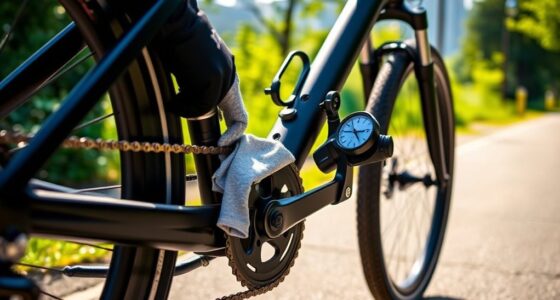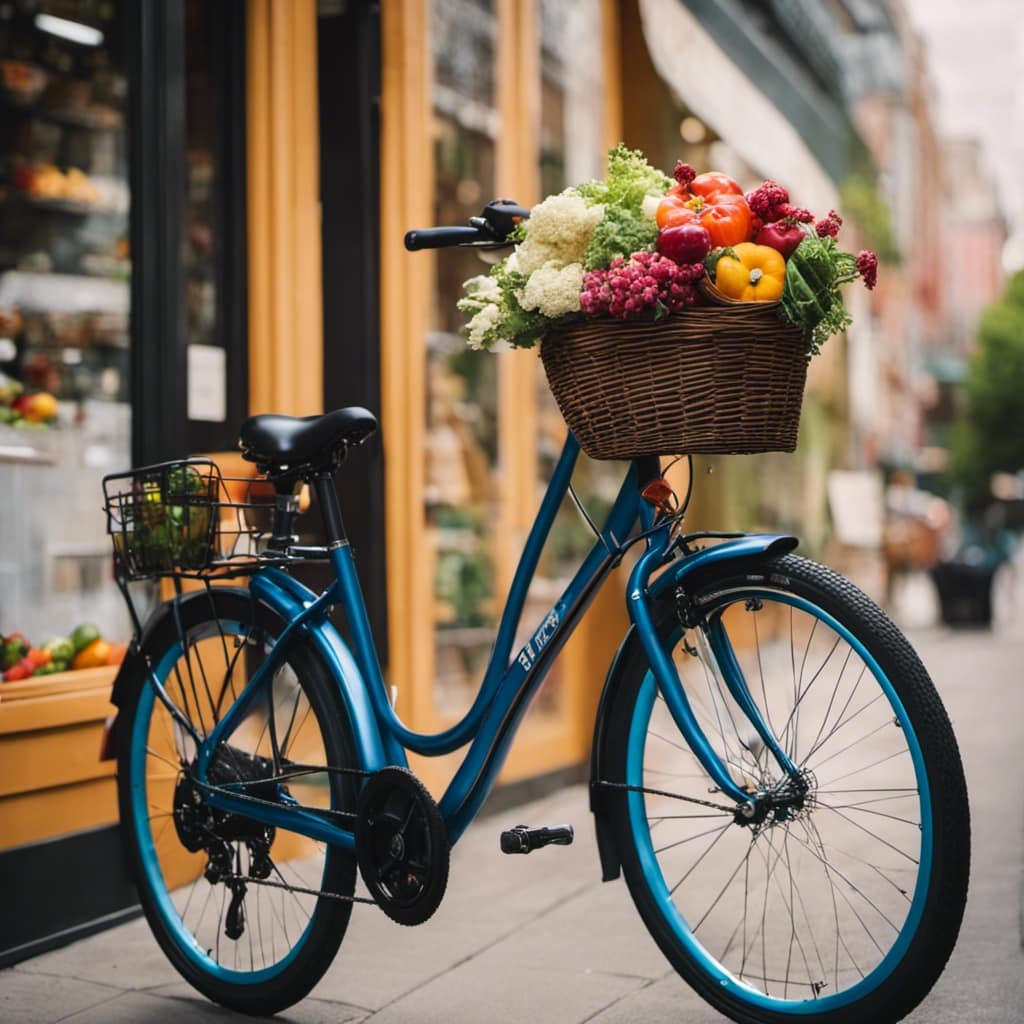To keep your hybrid bike in top shape, check and inflate your tires regularly, inspecting for cracks or damage. Replace worn brake pads and frayed cables promptly. Keep your chain clean, lubricated, and properly tensioned. Tighten all bolts and components, including quick-release levers and wheel axles. Clean your bike after rides and ensure gears shift smoothly by adjusting derailleurs. Monitoring wheel alignment and scheduling professional tune-ups can extend its lifespan. More tips to maintain your bike’s peak performance await you.
Key Takeaways
- Regularly inspect and maintain tires, ensuring proper inflation and checking for cracks or damage.
- Keep brake systems responsive by inspecting pads, cables, and ensuring proper tension.
- Secure quick-release levers and components, checking for proper engagement and torque.
- Clean and lubricate the chain, gears, and cables to prevent rust and ensure smooth shifting.
- Conduct routine checks on bolts, spokes, and wheel alignment for safe, smooth rides.
Regularly Check and Inflate Your Tires
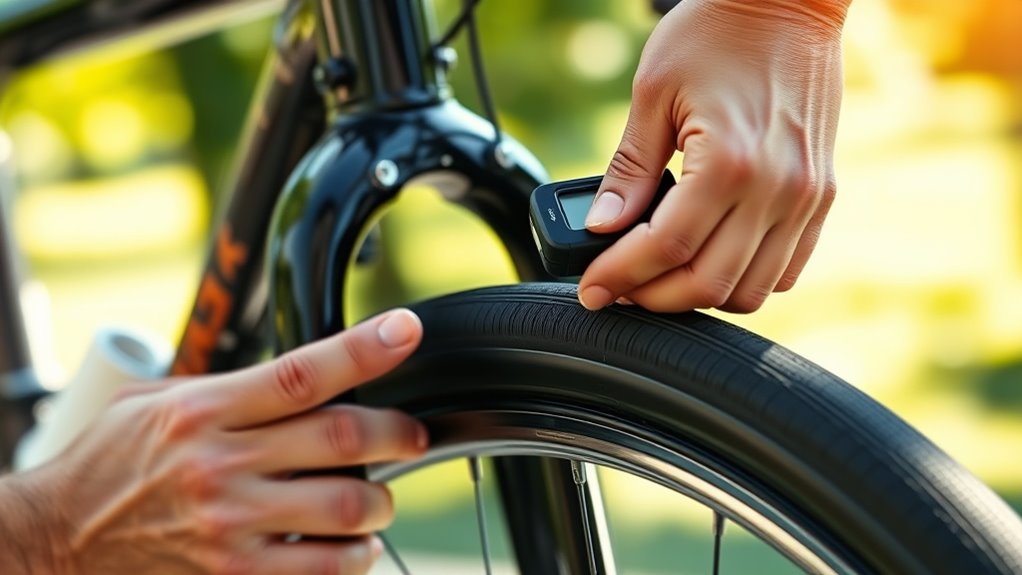
To keep your hybrid bike running smoothly, you should check and inflate your tires regularly. Tire pressure is key to a safe, comfortable ride and helps prevent flats. Every 3-4 days, use a reliable gauge to check the pressure, aiming for the recommended PSI on the sidewall—usually 60-80 PSI for city riding. If the pressure drops, grab a pump and inflate your tires slowly until they reach the proper level. Properly inflated tires reduce rolling resistance, making pedaling easier, and extend your tires’ lifespan. Regularly inspecting your tires for cracks, cuts, or dry rot is also essential, especially if your bike has been unused for a while. Maintaining optimal tire pressure is crucial for both safety and performance. Staying on top of tire pressure and inflation keeps your ride smooth and helps avoid unexpected flat tires. Regularly checking for wear and tear can help you identify potential issues before they lead to flats or accidents. Additionally, being aware of proper inflation techniques can ensure your tires are consistently maintained at the correct pressure. Celebrating your dedication to maintenance can also create a sense of life together and pride in your bike care routine.
Inspect and Replace Worn Brake Pads and Cables

You should regularly check your brake pads for uneven wear, cracks, or thinning, replacing them if they’re less than 1/8 inch thick. Inspect your brake cables for fraying, rust, or corrosion, and swap out any damaged ones immediately. Proper tension and smooth routing of cables are essential to keep your brakes responsive and reliable. Considering Mazda Tuning modifications, upgrading your brake system can further enhance stopping power and safety. Additionally, choosing top mattress toppers that provide pressure relief may improve your overall riding comfort during extended cycling sessions. Incorporating personal development techniques like mindfulness can also help maintain focus and calmness during rides, contributing to safer cycling experiences. For those interested in Kia Tuning, upgrading your vehicle’s brake components can offer improved performance and safety on the road.
Brake Pad Wear Indicators
Brake pad wear indicators are essential tools that help you determine when your brake pads need replacing. These small raised lines or tabs on the brake pads act as visual signals, showing when the pads have worn down to a critical level. When you hear a squealing noise during braking, it often indicates that the wear indicators are contacting the rim or rotor, signaling it’s time for brake pad replacement. Regularly inspecting these indicators ensures you catch wear early, preventing damage to rims or rotors and maintaining ideal braking performance. Keep in mind, even wear across the brake pads ensures consistent braking. Replacing worn brake pads promptly helps preserve your bike’s braking efficiency and safety, avoiding more costly repairs down the line.
Cable Fraying and Corrosion
Regularly inspecting brake and gear cables for fraying, rust, or corrosion helps maintain peak braking performance. Check cables at attachment points and along their length for signs of wear or corrosion that could compromise safety. Corroded or frayed cables can lead to decreased braking power, uneven stops, or even cable failure during rides. If you notice any damage, replace the cables and worn brake pads promptly. Before installing new cables, clean them with a cloth and contact cleaner to remove dirt and corrosion, ensuring smooth operation. Proper lubrication during maintenance helps prevent future corrosion and keeps cable movement effortless. Staying vigilant about cable condition is a simple but essential step to keep your hybrid bike’s brake system reliable and effective. Additionally, understanding the importance of air quality can help you maintain a healthier environment while riding or working on your bike, especially in urban areas. Regularly checking your cables and components can also help you spot potential issues before they become serious problems, ensuring safer rides. Incorporating sound healing science principles, such as gentle vibrations during maintenance, can also promote better overall health and focus while working on your bike.
Keep Your Chain Clean and Lubricated

Keeping your bike chain clean and well-lubricated is essential for smooth performance and longevity. Regular cleaning removes dirt, grime, and old lube, preventing premature wear. Use a biodegradable degreaser and a brush to thoroughly clean the chain. Afterward, apply a bicycle-specific lube evenly while backpedaling, then wipe off excess to avoid attracting dirt. In dry conditions, opt for dry lube; in wet or muddy environments, choose wet lube to prevent rust and maintain ideal performance. Periodically check chain wear with a chain checker tool; replace if it exceeds the stretch limit. Proper maintenance reduces friction, prolongs component life, and ensures smooth gear shifting. Maintaining correct chain tension is also vital for optimal riding experience and preventing undue stress on drivetrain components.
Tighten and Secure All Bolts and Components
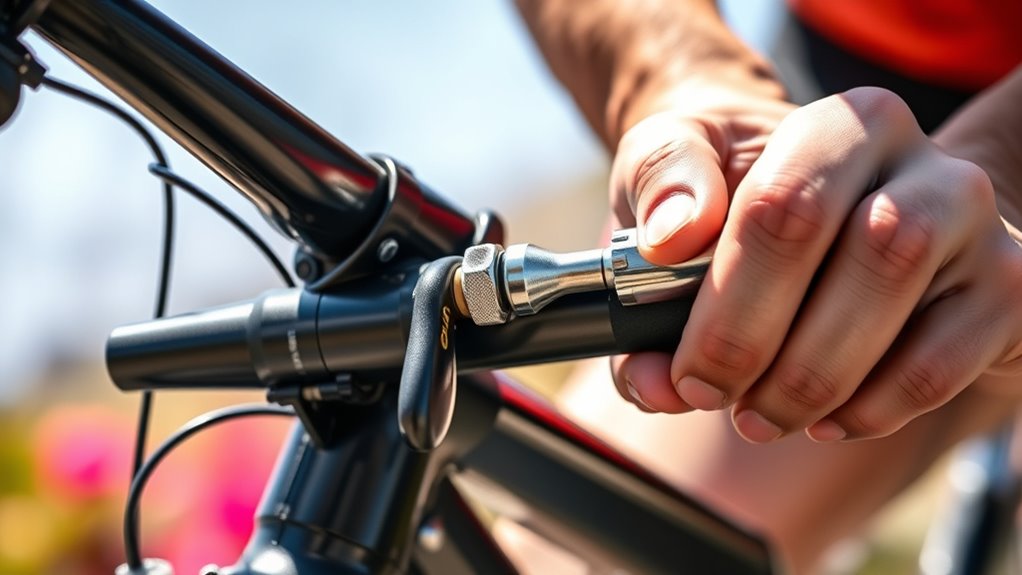
Regularly check that all bolts on your bike are tight to prevent parts from coming loose during rides. Make sure quick-release levers are fully closed and secure before you hit the road. Inspect for any loose components and tighten them as needed to keep your bike safe and functioning properly. Staying informed about latest machine learning advancements can help you understand how evolving technology might impact future bike features and safety systems.
Check Bolt Tightness Regularly
Ensuring all bolts are properly tightened is essential for safe and reliable riding. Regularly checking bolt tightness helps prevent components from shifting or detaching, ensuring your bike performs well and stays safe. Use a torque wrench to accurately tighten bolts according to manufacturer specs. When inspecting, picture: 1. Visualizing the bolt on your stem, ensuring it’s snug. 2. Feeling the seat post bolt for firm resistance. 3. Listening for any creaking from wheel axles. 4. Confirming brake calipers are securely tightened. Regular maintenance and awareness of component integrity can extend your bike’s lifespan and minimize unexpected failures. Additionally, understanding heat pump efficiency can help you better grasp how proper maintenance impacts overall system performance and energy savings. Recognizing narcissistic traits in behaviors can help you better understand and manage interactions with difficult individuals. Additionally, understanding sailing imagery can inspire a sense of adventure and appreciation for your cycling journeys. Routine inspections can also help identify early signs of wear and tear, preventing potential breakdowns during rides.
Confirm Quick-Release Securely
Verifying that quick-release levers are properly secured is essential for safe riding. Ensure the quick-release skewer is fully closed and tightened to the recommended torque, preventing the wheel from wobbling or coming loose. Check that the quick-release lever is snug against the dropout and cannot be easily moved or opened with minimal force. Properly centered skewers on both sides help keep the wheel secure and aligned. Regularly inspect the quick-release for signs of wear, corrosion, or damage, replacing any compromised parts. If your bike manufacturer recommends using a torque wrench, utilize it to confirm these components are tightened to the correct specifications. Proper maintenance of quick-release mechanisms can prevent potential accidents and prolong the lifespan of your components. Additionally, quick-release security is vital, especially for frequent riders or those riding on rough terrains. Securing your quick-release properly guarantees your wheel stays firmly in place during rides, ensuring your safety and bike performance. Regularly checking for component wear can help identify issues early and maintain optimal safety standards.
Inspect for Loose Components
To keep your hybrid bike safe and performing well, it’s important to check that all bolts and nuts are properly tight and secure. Loose components can lead to accidents or damage. Here’s what to look for:
- Feel around handlebars and stem for any loose bolts or wobbling.
- Check the seat post and saddle for any movement or squeaking.
- Inspect brake calipers and ensure bolts and nuts are tight and not slipping.
- Verify quick-release levers and thru-axles are fully engaged and securely locked.
Pay close attention after transporting your bike or riding on rough terrain. Tighten any loose bolts and nuts immediately. Securing all components prevents wear and keeps your ride safe and smooth.
Clean Your Bike Thoroughly After Rides

After every ride, take the time to clean your hybrid bike thoroughly to keep it in top shape. Regular cleaning prevents dirt, mud, and grime from causing corrosion or damage. Use a biodegradable degreaser and a soft brush to carefully clean the drivetrain, including the chain, chainrings, cassette, and derailleur. Wipe down the entire bike frame with a damp cloth to remove dirt that can wear down components. Pay special attention to brake and gear cables, lubricating pivots and housings to prevent rust and ensure smooth shifting. Rinse the bike with low-pressure water to avoid forcing dirt into sealed bearings. Dry the bike completely with a clean rag, then apply lubricant to moving parts to keep everything functioning smoothly for your next ride.
Monitor and Adjust Gear Shifting Performance

Keeping your gear shifting smooth requires regular checks and adjustments. To do this, focus on your derailleur and cable tension. First, examine the derailleur hanger to ensure it’s straight; misalignment causes poor shifting. Next, inspect and clean the derailleur components to prevent dirt buildup that can cause slipping. Then, use barrel adjusters to fine-tune the cable tension—tighten for sluggish shifts, loosen if gears skip or feel overly sensitive. Lastly, replace worn or stretched cables and housing promptly to maintain ideal tension. After adjustments, shift through all gears to verify each engages smoothly without hesitation or noise. Regularly monitoring and tweaking these elements keeps your gear shifting responsive and reliable, making every ride smoother.
Inspect and Maintain Wheel Alignment and Spokes

Regularly inspecting your wheel alignment and spokes is essential for a safe and smooth ride. Spin your wheels to check for wobbles, which signal misalignment or loose spokes needing truing. Examine spokes for looseness, rust, or damage, and tighten or replace them to keep the wheel strong. Use a spoke tension meter to ensure all spokes are evenly tensioned within the manufacturer’s recommended range, promoting wheel stability. When truing the wheel, adjust spoke nipples with a spoke wrench, centering the rim and ensuring it runs straight without rubbing brakes. Also, periodically check the hub bearings for smooth rotation; any roughness or play can affect wheel performance. Keeping your spokes tight and your wheel properly aligned prevents costly repairs and ensures a safe ride.
Schedule Periodic Professional Tune-Ups
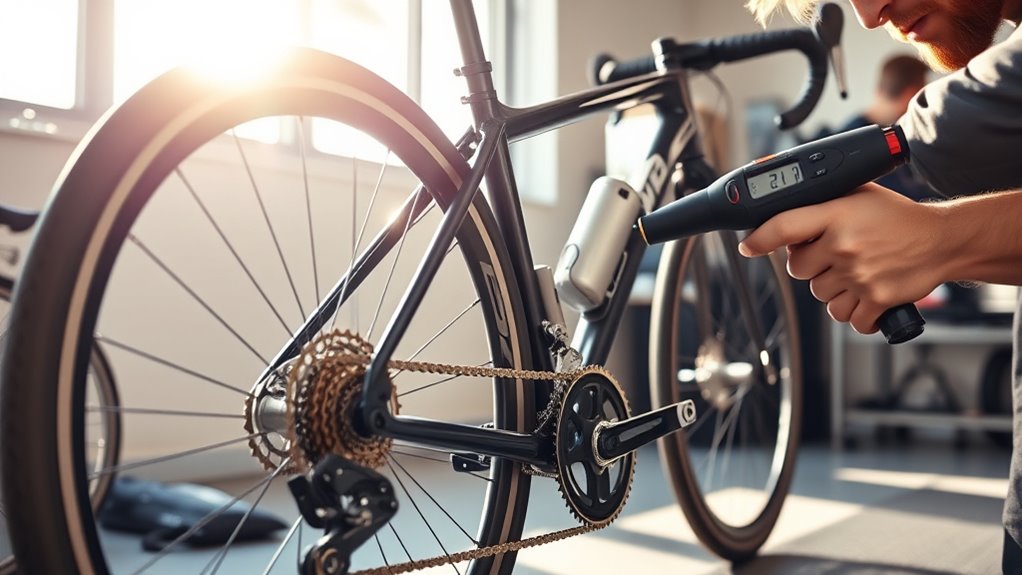
How often should you have your hybrid bike professionally serviced? Ideally, schedule professional tune-ups at least once a year or every 2,500 miles. During these service visits, the bike shop will perform essential bike maintenance, including:
Schedule annual or 2,500-mile professional tune-ups to keep your hybrid bike in top shape.
- Truing wheels to keep your ride smooth and safe
- Adjusting brakes and gears for peak performance
- Lubricating bearings to prevent wear
- Conducting drivetrain cleaning to remove grime and improve shifting
These tune-ups catch developing issues early, saving you money and extending your bike’s lifespan. Regular professional service ensures your hybrid bike stays in top shape, especially when preparing for seasonal changes. Keep track of your maintenance schedule to maintain peak performance and enjoy trouble-free rides.
Frequently Asked Questions
What Are the Disadvantages of Hybrid Bikes?
Hybrid bikes have some disadvantages you’ll want to contemplate. Their heavier frames can slow you down and cause fatigue on long rides. Wider tires create more rolling resistance, making pedaling less efficient on smooth pavements. The mix of mountain and road components can also mean more complex maintenance and higher repair costs. Plus, they lack specialized features like advanced suspension or aerodynamics, limiting performance in specific riding environments like racing or technical trails.
What Maintenance Should You Do on a Bike?
You should regularly check and clean your bike’s drivetrain, including the chain, cassette, and chainrings, to keep everything running smoothly. Make sure your tires are properly inflated within the recommended PSI range for safety and efficiency. Tighten and adjust brake and derailleur cables for peak performance. Lubricate moving parts like the chain and shifters, and check that bolts and nuts are secure to ensure your bike stays safe and reliable.
How Often Should I Service My Commuter Bike?
Ever notice how your bike seems to run smoother just when you need it most? You should service your commuter bike every 3 to 6 months if you ride regularly, checking tire pressure, brakes, and chain. Monthly, keep an eye on these essentials. If you ride in tough conditions like rain or salt, do it every 1 to 2 months. An annual professional tune-up keeps everything in top shape for the long haul.
Are Hybrid Bikes Good for Everyday Use?
Hybrid bikes are perfect for everyday use because they combine comfort, versatility, and durability. You’ll find them ideal for daily commutes, errands, and casual rides around town. Their upright riding position, moderate tire width, and features like racks and fenders make your ride smooth and practical. With proper maintenance, your hybrid bike will serve you well for years, making daily travel easier and more enjoyable.
Conclusion
By following these simple steps, you’ll keep your hybrid bike in top shape, ensuring smooth rides and lasting performance. Stay vigilant with vigilant checks, tighten and tune, and regularly clean your components. This routine refreshes your ride, reduces repair risks, and reignites your passion for pedaling. Remember, consistent care creates a confident, comfortable cycling experience, so stay committed to your maintenance routine—your bike will thank you with miles of magnificent, maintenance-made magic.


